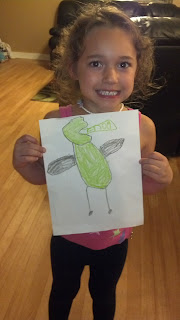My class has recently shifted from adding and subtracting three-digit numbers into measurement. According to my curriculum map we have 26 days to cover eight standards. With no time to waist we jumped right in. Here is my day by day on how I plan on covering the content .......
Our Math Board:
Day 1:
The students started out by brainstorming all that they knew about measurement. They used colored pencils to complete their bubble maps. I read the students the book, How Big Is A Foot. We acted out one of the events in the story by choosing a student and measuring him for a bed. We used copies of my foot and copies of another student's foot. We then compared the two measurements and discussed why it was important to have a standard unit of measurement. The students recorded their answers in their math journals and shared them with the class.
After sharing journal entries I showed students an actual ruler. We discussed that there were 12 inches on every ruler and that is always equal to 1 foot. The students used one inch tiles to trace onto cardstock in order to make their own personal rulers. I passed out packs of chipboard lines and the groups worked together using both tiles and their rulers to measure the line segments and record onto their worksheet. I collected their sheet for another day.
Day 2:
We reviewed what a standard unit of measurement is and discussed how many inches equal one foot. I introduced three tools that measure in inches: ruler, yard stick, and tape measure. We discussed how you would know which tool to pick when measuring objects (less than or equal to a foot should be measured with a ruler, between one and three feet should be measured with a yard stick, more than three feet should be measured with a tape measure). There was a pretty in depth debate on how all tools can be used to measure different objects but there are "good fit" tools that can make the job easier. I passed out a set of tools to each group and let them have five minutes to use them. We came back together and discussed the similarities and differences between the tools (this went right along with our comparing and contrasting unit we have been covering in reading) and the students individually completed a 3-2-1 in their math journals; 3 ways the tools were different, 2 ways they were the same, and 1 question they still had. After sharing, the groups were each given a task card with three objects on it. Each card had a "good fit" object for each tool. The students moved around the room finding and measuring them. When all groups were finished we met on the rug, shared our findings, and created a "Measure Around the Room" anchor chart. This is what it looked like:





Day 3-4:
On days three and four we repeated the activities from the first two days shifting our focus to centimeters instead of inches. The students used the same line segments and task cards to complete their activities. We discussed the difference between the two measurements: It takes more centimeters than inches to measure the same length because centimeters are smaller than inches. This is a brainstorming map we created after reading a book on centimeters and meters:
Day 5:
This was the day of Jump Rope for Heart, the sweetheart dance, and our Valentine's Day ice cream party. Due to all of the festivities we did not have our regular math block. We did squeeze in some academic centers that morning though. The math center was something I got from an Amy Lemons unit called the "measurement garden." The students had to measure the flowers in inches and then cut and glue them in order from shortest to tallest.

Day 6: This was a pretty tough lesson for the class...all about conversions. Although conversions are not an actual part of our standards, the students do have to be able to compare lengths that have been measured with two different units (inches/centimeters; feet/yards; etc.). I gave the students a partially filled in worksheet that had objects measured with more than one unit. The students were then given the measurement tools and as a team had to determine what the equivalent measurement would be. Some of the students set the problems up as repeated addition and others preferred to actually measure the objects themselves. This is what it looked like...


Day 7-9: During these days we focused on estimating. The first day I showed the students the word "estimate" and had them brainstorm in their groups what they thought it meant. We then made a class bubble map of all of their definitions. Once we understood the word we broke up into centers. Each group went to two centers a day. The first day we focused on estimating and measuring objects using only inches and the second day we repeated the same centers using centimeters. By the third day we mixed both centimeters and inches to make sure the students could correctly pick the appropriate unit. The objects we measured were also from Amy Lemons measurement unit.


Day 10: This week we started off by reviewing estimation. I showed the class a giant Slim Jim (I wanted a Pixie Stick but I couldn't seem to find one in the stores :) and a one-inch tile. Each group had a chance to see the objects. When everyone was done they wrote down their estimate of how long they thought the treat was. We took the information and made a line plot with the data (a new Common Core standard for second grade). We continued using estimation activities and discussing our findings.
Day 11-12: During this time we shifted our focus to identifying differences in lengths. We started out by selecting two objects, estimating how long we thought they were (in inches or centimeters), and then subtracting the lengths to find the difference. We used many classroom objects as well as our beach measuring centers that we worked on previously in this unit. We also paired up with a buddy to find out who had the longest pencil. Partners had to estimate the length, measure, and subtract. We collected group Post-It notes and displayed them on a class poster.






Day 13-14: We spiraled our estimating and differences in length into our tier II math time and continued plugging along with the next concept. This time our focus was on identifying, using, and creating number lines. I started out by showing the students a "broken" ruler and asking the students if a ruler like this could be used to accurately measure. Naturally, most of the class said no. I showed them how to use the ruler even if the numbers didn't start at 1. They thought this was pretty cool! We then related how a broken ruler can be similar to a number line. Some number lines start at 0 (like a ruler) but others start at different numbers. Over the next day and a half (half of one day went to our monthly nutrition presentation), the class practiced using a ruler to draw and label their own number lines, completing equations and word problems using number lines, and making equations to match other students number lines.

Day 15-26: Whew! When I say these days have been a blur, I mean it! Things have been CRAZY busy at school! We have had CIM checks, LIA testing, the kindergarten play, and nutrition presentations. Busy, busy, busy! Even so, the kids have been awesome about adapting to everything and have worked very hard. I am happy to say measurement is finally complete! In a nutshell, these are the concepts/standards that we have covered:
CCSS.Math.Content.2.MD.A.1 Measure the length of an object by selecting and using appropriate tools such as rulers, yardsticks, meter sticks, and measuring tapes.
CCSS.Math.Content.2.MD.A.2 Measure the length of an object twice, using length units of different lengths for the two measurements; describe how the two measurements relate to the size of the unit chosen.
CCSS.Math.Content.2.MD.A.4 Measure to determine how much longer one object is than another, expressing the length difference in terms of a standard length unit.
CCSS.Math.Content.2.MD.B.5 Use addition and subtraction within 100 to solve word problems involving lengths that are given in the same units, e.g., by using drawings (such as drawings of rulers) and equations with a symbol for the unknown number to represent the problem.
CCSS.Math.Content.2.MD.B.6 Represent whole numbers as lengths from 0 on a number line diagram with equally spaced points corresponding to the numbers 0, 1, 2, ..., and represent whole-number sums and differences within 100 on a number line diagram.
CCSS.Math.Content.2.MD.D.9 Generate measurement data by measuring lengths of several objects to the nearest whole unit, or by making repeated measurements of the same object. Show the measurements by making a line plot, where the horizontal scale is marked off in whole-number units.
CCSS.Math.Content.2.MD.D.10 Draw a picture graph and a bar graph (with single-unit scale) to represent a data set with up to four categories. Solve simple put-together, take-apart, and compare problems1 using information presented in a bar graph.





























